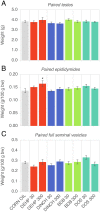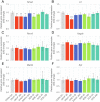Effects of In Utero and Lactational Exposure to New Generation Green Plasticizers on Adult Male Rats: A Comparative Study With Di(2-Ethylhexyl) Phthalate
- PMID: 29945229
- PMCID: PMC6016686
- DOI: 10.1093/toxsci/kfy072
Effects of In Utero and Lactational Exposure to New Generation Green Plasticizers on Adult Male Rats: A Comparative Study With Di(2-Ethylhexyl) Phthalate
Abstract
Di(2-ethylhexyl) phthalate (DEHP), a widely used plasticizer, is a ubiquitous environmental contaminant and may act as an endocrine disruptor. Early life exposures to DEHP may result in anti-androgenic effects, impairing the development of the male reproductive tract. However, data on the long-lasting consequences of such DEHP exposures on adult male reproductive function are still rare and discrepant. Previously, we identified 2 novel plasticizers, 1,4-butanediol dibenzoate (BDB) and dioctyl succinate (DOS), as potential substitutes for DEHP that did not reproduce classically described endocrine disrupting phenotypes in prepubertal male offspring after maternal exposure. Here, we investigated the consequences of in utero and lactational exposure to BDB and DOS on adult male rat reproductive function in a comparative study with DEHP and a commercially available alternative plasticizer, 1,2-cyclohexane dicarboxylic acid diisononyl ester (DINCH). Timed pregnant Sprague Dawley rats were gavaged with vehicle or a test chemical (30 or 300 mg/kg/day) from gestation day 8 to postnatal day 21. While DEHP exposure (300 mg/kg/day) significantly increased epididymal weight in the adult, exposure to DINCH, BDB, or DOS did not affect reproductive organ weights, steroid levels, or sperm quality. Using a toxicogenomic microarray approach, we found that adult testicular gene expression was affected by exposure to the higher dose of DEHP; transcripts such as Nr5a2, Ltf, or Runx2 were significantly downregulated, suggesting that DEHP was targeting estrogen signaling. Lesser effects were observed after treatment with either DINCH or BDB. DOS exposure did not produce such effects, confirming its potential as a responsible substitute for DEHP.
Figures





Similar articles
-
In Utero and Lactational Exposure Study in Rats to Identify Replacements for Di(2-ethylhexyl) Phthalate.Sci Rep. 2017 Jun 20;7(1):3862. doi: 10.1038/s41598-017-03979-0. Sci Rep. 2017. PMID: 28634325 Free PMC article.
-
A dose response study following in utero and lactational exposure to di-(2-ethylhexyl) phthalate (DEHP): reproductive effects on adult male offspring rats.Toxicology. 2006 Nov 10;228(1):85-97. doi: 10.1016/j.tox.2006.08.020. Epub 2006 Aug 22. Toxicology. 2006. PMID: 16996189
-
Repeated exposures of the male Sprague Dawley rat reproductive tract to environmental toxicants: Do earlier exposures to di-(2-ethylhexyl)phthalate (DEHP) alter the effects of later exposures?Reprod Toxicol. 2016 Jun;61:136-41. doi: 10.1016/j.reprotox.2016.03.046. Epub 2016 Mar 31. Reprod Toxicol. 2016. PMID: 27040317 Free PMC article.
-
Prenatal phthalate exposure: epigenetic changes leading to lifelong impact on steroid formation.Andrology. 2016 Jul;4(4):573-84. doi: 10.1111/andr.12175. Epub 2016 Apr 4. Andrology. 2016. PMID: 27044004 Review.
-
Mechanistic considerations for human relevance of cancer hazard of di(2-ethylhexyl) phthalate.Mutat Res. 2012 Apr-Jun;750(2):141-158. doi: 10.1016/j.mrrev.2011.12.004. Epub 2011 Dec 20. Mutat Res. 2012. PMID: 22198209 Free PMC article. Review.
Cited by
-
Exposure to the non-phthalate plasticizer di-heptyl succinate is less disruptive to C57bl/6N mouse recovery from a myocardial infarction than DEHP, TOTM or related di-octyl succinate.PLoS One. 2023 Jul 13;18(7):e0288491. doi: 10.1371/journal.pone.0288491. eCollection 2023. PLoS One. 2023. PMID: 37440506 Free PMC article.
-
Mechanisms of MEHP Inhibitory Action and Analysis of Potential Replacement Plasticizers on Leydig Cell Steroidogenesis.Int J Mol Sci. 2021 Oct 24;22(21):11456. doi: 10.3390/ijms222111456. Int J Mol Sci. 2021. PMID: 34768887 Free PMC article.
-
Insights into the Endocrine Disrupting Activity of Emerging Non-Phthalate Alternate Plasticizers against Thyroid Hormone Receptor: A Structural Perspective.Toxics. 2022 May 19;10(5):263. doi: 10.3390/toxics10050263. Toxics. 2022. PMID: 35622676 Free PMC article.
-
Phthalates and Phthalate Alternatives Have Diverse Associations with Oxidative Stress and Inflammation in Pregnant Women.Environ Sci Technol. 2019 Mar 19;53(6):3258-3267. doi: 10.1021/acs.est.8b05729. Epub 2019 Mar 11. Environ Sci Technol. 2019. PMID: 30793895 Free PMC article.
-
Screening of Potential Plasticizer Alternatives for Their Toxic Effects on Male Germline Stem Cells.Biomedicines. 2022 Dec 12;10(12):3217. doi: 10.3390/biomedicines10123217. Biomedicines. 2022. PMID: 36551973 Free PMC article.
References
-
- Akingbemi B. T., Youker R. T., Sottas C. M., Ge R., Katz E., Klinefelter G. R., Zirkin B. R., Hardy M. P. (2001). Modulation of rat Leydig cell steroidogenic function by di(2-ethylhexyl)phthalate. Biol. Reprod. 65, 1252–1259. - PubMed
-
- Albert O., Jégou B. (2014). A critical assessment of the endocrine susceptibility of the human testis to phthalates from fetal life to adulthood. Hum. Reprod. Update 20, 231–249. - PubMed
-
- Albert O., Nardelli T. C., Hales B. F., Robaire B. (2018). Identifying Greener and Safer Plasticizers: A 4-Step Approach. Toxicol. Sci. 161, 266–275. - PubMed
-
- Andrade A. J. M., Grande S. W., Talsness C. E., Gericke C., Grote K., Golombiewski A., Sterner-Kock A., Chahoud I. (2006). A dose response study following in utero and lactational exposure to di-(2-ethylhexyl) phthalate (DEHP): Reproductive effects on adult male offspring rats. Toxicology 228, 85–97. - PubMed
Publication types
MeSH terms
Substances
Grants and funding
LinkOut - more resources
Full Text Sources
Other Literature Sources
Miscellaneous

